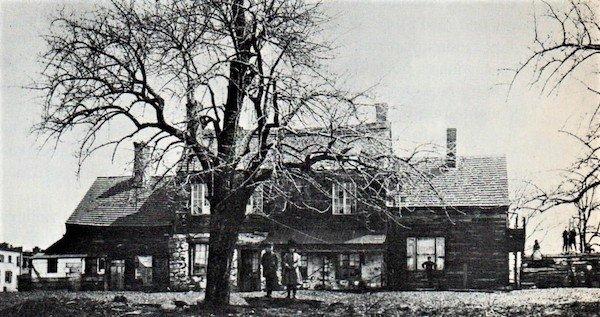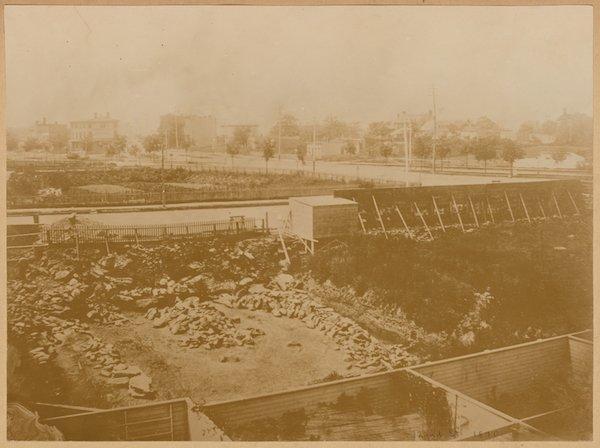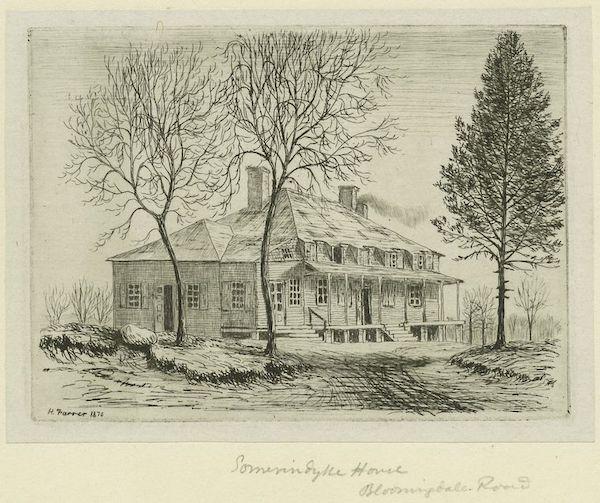
The Harsen homestead, via NY-Historical Society.
The Village of Harsenville was an 18th Century hamlet nestled in Manhattan’s former Bloomingdale District between 68th and 81st Streets and from Central Park to the Hudson River. Taking its name from the Harsen family, the land was settled as a tobacco farm in the mid-1700s by Jacob Harsen and Catherine Cosine, first cousins who slept in the same crib and would ultimately marry.
Advertisement
The farm itself was centered at Broadway and 73rd Street, with its homestead located at the now-named Amsterdam Avenue and 70th Street in 1763. The farm’s entirety reportedly spanned from 69th to 73rd Streets, from Central Park West (formerly 8th Avenue) to Riverside.

“Jacob Harsen homestead; open lots.” Via New York Public Library.
Various online sources create uncertainty about the farm’s bloodlines, original ownership, and namesake. This confusion is likely caused by interconnecting familial relationships between the Dyckman and Cosine families.
READ MORE: Edgar Allan Poe’s Two Years in an Upper West Side Farmhouse
The predominant story available through online sources is that the 94-acre farm was purchased by one of many men named Cornelius Dyckman (also seen as Dikeman and Dykeman) in 1701. Alternative sources report that the land was owned by Cornelius Cosine. All sources agree, however, that the property was eventually deeded to husband and wife Jacob Harsen and Catherine Cosine.
Sources often report that both Cornelius Dyckman and Cornelius Cosine are Catherine Cosine’s father – or even her grandfather – often seeming to confuse the two as the same person but with different and incorrect lines to Catherine. However, the most detailed account of the Harsen Farm lineage comes from The New York of Yesterday by Hopper Striker Mott. Long story short, Nicholas Dyckman, father to Jacob’s and Catherine’s mothers, owned the land. Jacob’s father was the executor of Nicholas’ will and conveyed part of the land to his brother who was also named Jacob. It is believed Harsenville took its name from the elder Jacob, and not the Jacob who was married to Catherine.
Advertisement
However, Catherine’s husband Jacob is the one who settled the family’s land as a tobacco farm. This Jacob is often credited with being the namesake of the village, and likely so because soon after the Harsen farm came to be, other farming families followed, “setting up what became a small village, complete with schools, churches, and shops.”
READ MORE: The Old Apthorp Mansion of the Upper West Side
One of these families was the Somarindycks, whose farm stretched from Columbus Circle to 75th Street. 6sqft reports that Prince Louis Philippe lived at the Somarindyck home on 75th and Broadway while he was exiled from France. The family’s second home, at 77th Street, was purchased in the late 1840s by Fernando Wood who “lived there while he served as NYC Mayor.”

Somerindyke House, Bloomingdale Road. Via New York Public Library.
Harsenville itself no longer existed after 1911. The Harsen family had some of its land confiscated by eminent domain in 1849 to widen Bloomingdale Road (today’s Broadway) between 70th and 71st Streets, before being reduced again in 1869 to create a traffic triangle. Soon thereafter, the Harsen family reportedly sold parts of their land in the 1870s and the end of the family’s time on their remaining land is unknown.

“The last of Harsenville,” September 1873. Via New York Public Library.
By all accounts, the Harsens were a respected family. Jacob was said to be “a man of influence, of strong will, and decided character,” the leader of a “serene life of comfort and content” despite four of his five children dying young, writes Mott in The New York of Yesterday. Cornelius, the surviving son of Jacob and Catherine, served as a colonel in the War of 1812. Their grandson, also named Jacob, was a well-known doctor who bequeathed sixteen lots of land at 70th and 8th Avenue to the College of Physicians and Surgeons.
Advertisement
Farmer and settler Jacob was a founding member of the Church at Harsenville, whose first location was built on the Harsen Farm just south of the main residence. He served on the Board of Deacons of the Collegiate Church and served as on officer of the school, founded in 1633 – “the oldest educational institution in continuous existence in New York.” Both he and Catherine passed away in 1835, approximately two months apart after 62 years of marriage.
At its peak, Harsenville was said to have 500 residents and 60 buildings. However, there are but few reminders of the village that remain on the Upper West Side. The present-day triangular area from 70th Street to 73rd Street on Broadway is said to take this form because of the farm’s original shape. Harsen House at 120 West 72nd, a 16-story condominium, takes its name from the area’s former settlers.
However, the memory of Harsenville, and the Harsen farm in particular, is remembered fondly by Mott in his 1908 The New York of Yesterday. Said of the Harsen’s farmland, “broad were the acres surrounding their home from the rear piazza of which the river drew, terminating in the heights beyond, dazzled the beholder. Oh, those days of yore! How they do return in memory to disparage the present.”



Beautiful post! How interesting
Latest research indicates that the Collegiate School was founded in 1628.
And what of the slaves who undoubtedly worked the property?